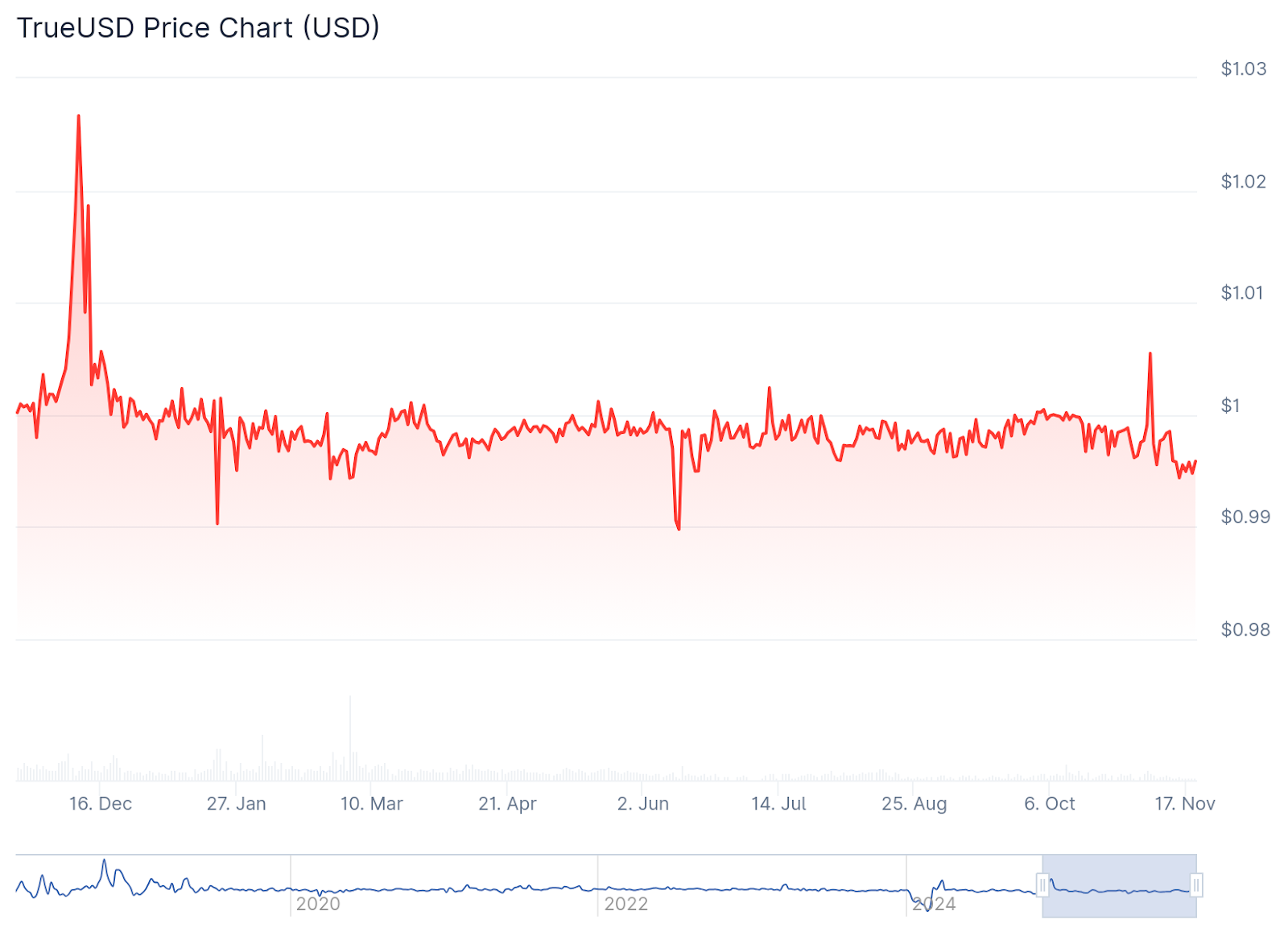S&P Global Ratings gave TrueUSD (TUSD) its lowest stability grade, saying the stablecoin faces a "weak" ability to hold its $1 peg. The move comes as a Dubai court ordered an asset freeze on roughly $456 million linked to TUSD reserves, while TRON founder Justin Sun has stepped in with liquidity to keep redemptions flowing.
Key points at a glance
- S&P rated TUSD a 5 on its 1-5 scale (1 = "very strong," 5 = "weak"), citing governance and transparency risks, and warning the peg may fail without ongoing support (assessment published Nov. 14).
- About $456 million in reserves was sent to a Dubai trading firm, Aria Commodities DMCC, for investment between June 2021 and March 2022, according to court filings by issuer Techteryx. Funds are now under a court-ordered freeze while litigation proceeds (filings; order dated Oct. 17).
- Techteryx, which acquired TUSD in December 2020, reportedly relied heavily on a single custodian, First Digital Trust Ltd., to hold reserves, raising concentration risk, S&P said.
- A spokesperson for Justin Sun said he advises Techteryx and provided nearly $500 million in liquidity to support redemptions while the dispute plays out.
Why this matters
Stablecoins are meant to stay at $1 and act like cryptos cash. When confidence drops, users worry about getting dollars back on demand. That can spill into Decentralized Finance (DeFi) apps, exchanges, and trading pairs that rely on these tokens as a safe parking spot.
S&Ps rating puts TUSD at the bottom of its scale and signals that the coins stability depends on ongoing backstops rather than a simple, boring reserve model. That makes TUSD more sensitive to headlines, legal outcomes, and the actions of a few key players.
What S&P flagged
The agencys write-up points to several weak spots:
- Governance and disclosure: limited public information on Techteryxs ownership and activities, and no legal opinions confirming reserves are ring-fenced from the companys own assets.
- Reserve setup: most assets reportedly held with one custodian (First Digital Trust Ltd.), creating a single point of failure.
- Transparency gaps: even with real-time checks by Hong Kong firm Moore, S&P said key questions about asset quality and processes remain.
- Liquidity dependence: without continued support from Techteryx and backers, S&P warned the peg could slip.
The Dubai reserve dispute
Techteryx told the Dubai court it transferred roughly $456 million from TUSD reserves to Aria Commodities DMCC to invest. The court noted Aria has not shown clear records explaining how the money was used. Techteryx is suing Aria and several regional banks to recover funds, and the court has frozen the assets while the case continues.
In plain terms: money meant to back $1 stablecoins allegedly went into investments that the issuer now cant fully trace. That uncertainty is exactly the kind of risk that ratings agencies and users worry about.
Suns role and redemptions
According to a spokesperson, Justin Sun is an advisor to Techteryx and has supplied nearly $500 million in liquidity support so TUSD users can still redeem at $1 while reserves are tied up. S&P cautioned that if this support stops, the peg could be at risk.
Regulatory and history notes
S&P also pointed to prior issues related to earlier operators. The U.S. Securities and Exchange Commission filed a complaint against TrueCoin (a subsidiary of ArchBlock) and TrustToken (developer of the TrueFi lending protocol), alleging unregistered offers and sales of TUSD-related investment contracts from November 2020 to April 2023. Those firms agreed to settle, though court approval is still pending, S&P noted.
What this means for users
If you hold TUSD, your ability to get $1 back may rely on continued support from the issuer and its backers while the Dubai case unfolds. Thats different from a structure where highly liquid reserves are clearly segregated, diversified, and independently audited.
Definitions:
- Stablecoin: a crypto token designed to stay at $1.
- Peg: the fixed price target, often $1 per token.
- Custodian: a company that holds assets for safekeeping. Over-reliance on one custodian can be risky.
Market context
Stablecoins power much of cryptos day-to-day activity, from trading to payments to DeFi. When one looks shaky, traders can shift into rivals or move to cash, causing price wobbles and higher fees. Since January, TUSD has hovered at or slightly below $1, according to CoinGecko.

What to watch next
- Outcome of the Dubai case and whether frozen funds return to reserves.
- Any diversification of TUSDs custody beyond First Digital Trust Ltd.
- Stronger disclosures: independent audits, clear legal opinions on reserve segregation, and detailed holdings.
- Redemption activity: sustained $1 exits without delays are a key health check.
- Regulatory updates in the U.S. and abroad on stablecoin oversight.
Bottom line
S&P says a better stability score for TUSD is unlikely in the near term. Until the reserve dispute is resolved and governance improves, the coins peg appears to lean on confidence and backstops rather than transparent, diversified reserves.
